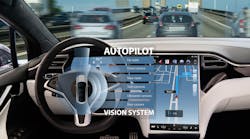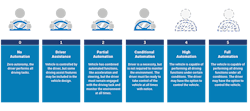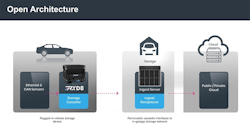What you'll learn:
- How do EVs and AVs differ technologically, and in consumer attitude?
- What is the "Tesla trend"?
- The need for in-vehicle data loggers in AVs.
Currently, apart from sharing a letter in their acronym, the relationship between electric vehicles (EVs) and autonomous vehicles (AVs) is one of mere association. Both have seen broader recognition among consumers in the past few years, having exited the R&D lab and entered the cultural zeitgeist.
However, significant technological differences exist between the two, consumer attitudes toward them differ, and their interesting and complementary relationship is set to continue evolving as the world approaches mainstream adoption of both EVs and AVs.
The Technological Differences Between EVs and AVs
EVs have been around for some time in one form or another. When you cut through the novelty, pomp, and circumstance, an EV ultimately just relies on another form of propulsion, contrasted with gasoline, diesel, and now hydrogen fuel cells.
With electric propulsion, components are broadly common to all EVs and fundamentally very simple—motor(s), battery, and controllers for those components to facilitate power application, regenerative braking, and charging.
Control mechanisms are now similar in each vehicle type—fly-by-wire motor control, electronic transmission control, brake-by-wire, electric power steering—meaning the application of driver aids on these systems is done using electronic communication between a network of modules.
The “Tesla Trend” and Its Impact on the EV Automotive Industry
The current trend/push toward EVs has happened simultaneously with advances in autonomy—let’s call it the “Tesla trend.” Not only has this manufacturer (Tesla) launched an electric brand using more efficient battery technology than previously seen, but also packed it with perceived cutting-edge driver aids. In a way, this has made the car even more of a must-have tech accessory, which appeals to a different demographic than say a traditional internal-combustion-engine (ICE) "analog" car.
Traditional auto manufacturers have struggled to catch up with the switch of mindset, and the response has been varied. Volvo probably led the way with assisted driving in its existing fleet of cars. At the same time, the company introduced hybrid or EV solutions in the form of its Polestar brand to ensure it could be considered a rival for Tesla. Other manufacturers are following suit at an accelerated pace, such as Volkswagen with its new "ID" range of EVs and BMW with its recent iX and i4 launches.
What are In-Vehicle Data Loggers, and Why are They Necessary for AVs?
In-vehicle data loggers are an integral piece of technology that enable AVs to function. Without the ability to log data as the vehicle drives, it would be impossible to consistently iterate and improve the way the overall system behaves, whether those adjustments are made manually or automatically (by means of an AI or machine-learning algorithm). Furthermore, on-the-road testing of advanced driver-assistance systems (ADAS) and AV algorithms is costly, borderline dangerous, and challenging from a regulatory perspective.
Loggers act as aggregators, capturing data from car body-mounted sensors such as cameras, LiDAR, radar, and GPS. This data can then be used later to simulate driving conditions on test benches in the safety and controlled environment of the lab to make observations and implement the necessary improvements.
Looking specifically at the levels of autonomy, we’re all familiar with the images of autonomous cars loaded with sensors, which are R&D vehicles in the Level 4/Level 5 end of autonomy, i.e. full autonomy (Fig. 1). You may have seen one driving down your street! These are effectively machine-learning vehicles, gathering data based on real-life scenarios where variables like traffic, roadworks, moving objects, weather, daylight, and road conditions come into play.
Importance of Connectivity
Advances in device connectivity and IoT have been crucial in enabling the end-to-end process of data capture, input, and output in AVs—from sensors to loggers, then the transfer from loggers to storage networks, and finally the upload to the public/private cloud. Operating systems such as Klas’s KlasOS Keel are a further enablement of this overall data web.
Such a robust level of data capture, transfer, and storage significantly smooths the R&D process. In addition, it will allow manufacturers to determine which sensors and cameras are relevant, and where technology voids exist. By implementing a refined well-proven onboard algorithm on an autonomous platform, in combination with the required ever-evolving input devices, manufacturers can implement a more aesthetically pleasing vehicle by integrating the required production hardware as part of the design.
The Klas angle, currently, is in the R&D phase for level 4 and level 5 autonomy (Fig. 2). Today, the gathering of data during R&D journeys is stored in the vehicles in an R&D logger (TRX D8), offloaded at the end of the drive and processed. Then this data used for constant algorithm development. The in-vehicle compute-and-storage piece is the TRX D8 and the offload mechanism is the ingest server, which Klas currently offers using a Dell server and its physical ingest receptacles.
In addition to the TRX D8 R&D Data Logger, Klas offers Compute, GPU, Switch, and Cellular Backhaul devices, all sharing the same modular form factor as the TRX D8. Complemented by the company’s range of in-vehicle chassis-mount options, the products combine to provide a market-ready solution for most components used in the autonomous-vehicle R&D industry.


